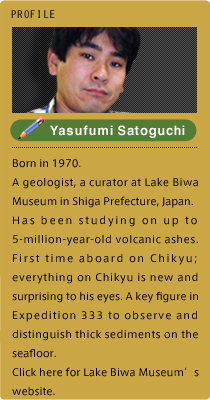

"Cruise is Done – A New Beginning"2011.1.28
The expedition 333 has finished. The science party including myself got off Chikyu on the 11th of January at Shingu port. Chikyu approached the port slowly as the land began to appear clearer and clearer.
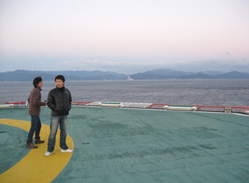
A couple of people who came out to the helicopter deck in early morning to see Shingu port, unable to wait to see the land after a long cruise. Cold but happy.
Chikyu got closer and closer to the port, but because she is a big ship, it had to be done slowly and carefully. The sunrise was beautiful on that day. Even the sun was celebrating our day of ‘going back to the land’.
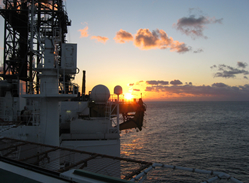
The last sunrise seen from this angle. Good weather.
A few days have passed after the day I got off the ship. Everyone should have got home safely and been back to their usual work. Well, I am back in my office and some extra work that has built up during my cruise has been making me wonder if my cruise was a dream. I guess everyone who was on Chikyu is now feeling the similar way.
The expedition 333 was rather a short cruise compared to the other expeditions, so maybe that is why I feel the cruise began and just finished in a blink. However, I do have the actual, numerous samples in front of me now. Yes, I was unmistakably on a ship. And from now on, I have to do all the analytical work of these samples. It will take a while to finish them all, but I also want to see the research data as soon as possible.
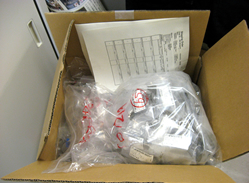
The samples I had been requesting. A box of samples sent from Chikyu to me… It wasn’t a dream that I was onboard! From now is the ‘analysis time’.
The other scientists who received their requested samples also should be feeling what I am feeling now. “Was it a dream? Oh, no! I’ve got the samples to analyse here!!” Or something like that. Yes, it is a new beginning; time to work on land.
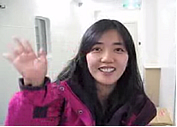
「I'll come back Chikyu again!」
This expedition report is the final one for expedition 333. I wonder if my reports could help the readers get acquainted to the excitement and importance of the cruise, but I would be very happy if it was helpful for you even a little. If you got interested in research cruises, especially those young scientists and who want to become scientists in the future, I would very much encourage you to try and go for your dreams.
Finally, I am finishing this report with this photo of us taken on Chikyu.
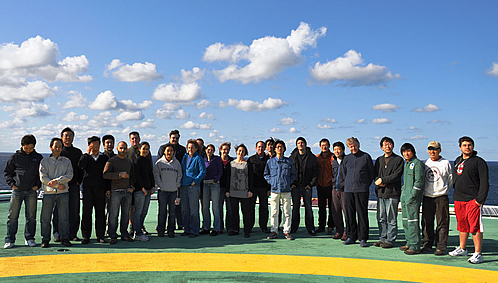
We had a problem in taking a good photo for the weather was not always great. It was a cold but sunny day when we took this one. Everyone was smiling!
Thank you very much for reading.
Yasufumi Satoguchi


"Working for One Purpose"2011.1.8
Hello, there. How have you been after the New Year holiday? I’m Satoguchi aboard Chikyu.
The expedition 333 is on its final stage. Each group is doing the surveys of expedition, trying to finish before they get off the ship. There are many discussions going on everywhere; some group discussions, inter-group discussions, and discussions on what to keep studying after getting off Chikyu, and so on. I can feel the heated atmosphere of the expedition’s last phase and scientists’ enthusiastic attitude!
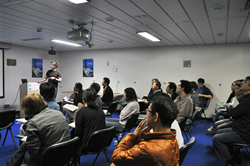
Each group is giving presentation on research progress and summary. Many scientists including the Co-Chief Scientist Pierre ask questions and lively debate follows...
Hmm… I feel like I’m writing too seriously and it’s getting almost “fake”, isn’t it? I’m writing the truth, but the way I’m writing is too serious! What should I do? I’m thinking about writing things like, “This scientist sitting next to me is newly-married, and he is telling me every day, ‘8 more days and this’ll be done!’ I wonder if he means he’s counting the days for he can’t wait to see his wife ASAP…”
Well, let’s return to the main subject. Recently, a thought came across my mind that this ship Chikyu is a deep sea drilling vessel, therefore she is cruising basically for the sake of “drilling”. This means that drilling engineers, we scientists, cleaning staff and catering staff are all working for that one ultimate purpose; to drill the seafloor thousands of metres below and do the research! This fact deeply impressed me, especially when I see cores coming up on deck.
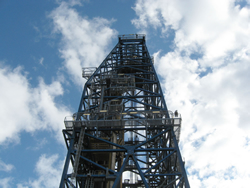
Every single staff on Chikyu is working for the boring cores drilled and taken up by THIS derrick. Now I’m so moved by its appearance.
Among all those staff, there are Lab technician. They support analytical and sampling works, checking and managing the cores for sampling and for archive.
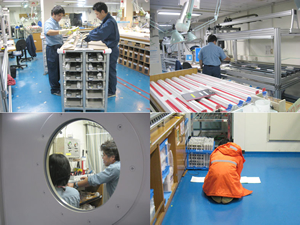
Technical staff dealing with processing cores, analysis support, management of archive cores etc. The lab for halving cores; half for sampling and half for archive (bottom left), photographing cores before describing (top right), organising cores after describing (bottom right), etc... However, why is she sitting on the floor (bottom right)?
Actually, without these Lab technicians, we scientists can not do anything! They are that important. I’ve often heard them arguing heatedly about the work procedures. They must have such passion for research and supporting the scientists, I think...
The expedition is almost ending, but for the scientists, the “real thing” or the research is just beginning. Each scientist has his or her research purposes. When they get off Chikyu, they will work on their results and samples back in their labs on land.
By the way, do all the cores go to scientists as their “samples” to work on? The answer is no. The cores get halved by Lab technicians, then “sampling half” goes to the scientists to work on, and the rest called “archive half” goes to Kochi Core Centre (Kochi Institute for Core Sample Research). If there were any errors or mistakes on core sample labels or data inputting, the Curator (the person in charge of core management. One of the Lab technicians.) comes literally running and mentions “Here, it says... Would you PLEASE correct it?” rather politely but firmly. I understand this kind of system for that’s similar to what I do in the museum. At the same time, I do also know how hard it is to be the curator to preserve and manage valuable materials, although what I deal with in the museum are not boring cores, but other things.
I’m finishing up this report with this photo from the table tennis tournament.
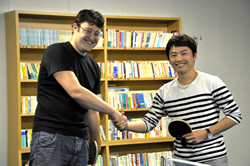
An excellent game by great players!
Yasufumi Satoguchi


“Starting Afresh; Beginning of 2011”2011.1.5
Happy new year! This is Satoguchi aboard Chikyu again. Even though it is a new year, we are working as usual, in our usual shift hours. I went out to the deck with other night shift people to see the sunrise. But unfortunately, it was cloudy, so we could not see the first sunrise of the year 2011, shame!
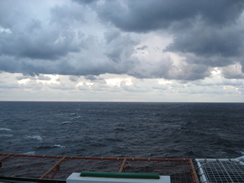
View of the sky from Chikyu at around the sunrise time.
Let’s continue with the interview. Moving on to the scientists from geochemistry field, and I have to admit that it is not really my cup of tea… Well, if you could read this report with some consideration for this, it would be highly appreciated.
I first went to Marion, who was working on her analysis nearby, trying to ask for some contribution to my interview for “Report from Chikyu”. She is working on her chemical entity of sediments by using an analyser called XRF.
Her target is to analyse the changes in chemical entities, to see how they change as the depth gets deeper. These changes, as she explains, are related to alteration conditions of the sediments. However, she says it takes so long to make samples for this analysis. Yes, the modification and so on do take time, I can imagine that.
Next, let’s ask Dr. Saito, whom I had known since before getting aboard Chikyu. His speciality used to be sedimentology, specialised in flood flow, but in this expedition, he is aboard as an inorganic geochemist. What changed him? Anyways, he says he is now studying the water within the underground sediments, and analysing their chemical behaviours/properties. So, what can he discover by studying them?
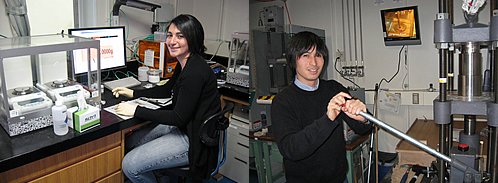
Marion (left) and Yu (Dr. Saito) from inorganic geochemistry group. Preparing samples for analysis. Yu is squeezing out the water contained in mud.
Yu says, “The sediments in the deep sea are literally building up in the ocean, so the particles are affected by sea water. Analysing how the sea water properties change can help us understand underground water movements. I suppose that such water movements are playing an important role in this particular area, where plate subduction and earthquake occur.
I see... So, what has excited him so far in this expedition? “I go to see the cores every time when they come up. The mud from below the seafloor has been under high pressure, so we need to make small holes for safety check first. When they do this, the mud comes out like pasta. It looks funny and I like it.”
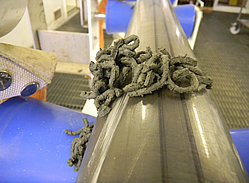
Pasta-like mud? Sometimes they burst, so the check has to be done carefully.
The last person to interview. Let’s ask this gentleman from organic geochemistry field. “Could I interview you, for a few minutes?” “Sure.” He replied with a shy smile. His real interest is the microorganisms that live in underground, but in this expedition, his work is based on organic compounds such as methane.
I simplify what he told me about his research here. In the ocean, clay and sand accumulate and form sediments on the seafloor. These sediments contain organic matters, which were produced by algae and bacteria on the ocean surface with plenty of sunlight. The measurements of these matters in the sediments are necessary for simulating the environments, such as ocean currents, sea water temperature, amount of nutrient etc., of millions to hundreds of thousands of years ago. Actually, when I was a little puzzled as I interviewed him, he said he would write me a simplified explanation. So, what I am writing here is based on his writing. It was so nice of him to help me with this report!
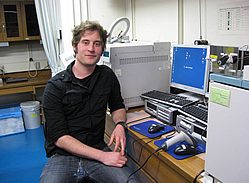
Thorsten from organic geochemistry group. His nickname is Thoddy. He looks like a fashion magazine model but talks about his research with his passion in his eyes. He must have lots of fans out there…! Photo taken in analytical processing lab.
So, thank you all the night-shifters who kindly contributed in my interview project. Why only night shifters? That is because I am a night shifter!
And for our new year celebration on the sea, we had “Kakizome” (a special calligraphy for new year) event.
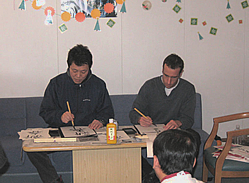
The co-chief scientists deeply absorbed in their Kakizome calligraphy. They wrote “New Year” and “Chikyu” in Japanese.
Yasufumi Satoguchi


“Let’s interview!”2010.12.31
Hello. The ship is rolling. I am looking into the microscope and feeling kind of “hmm…” Chikyu does not roll much. But in the past few days the waves have been rough and the cruise has been quite rocky. The microscope work on a rolling and tossing ship is uneasy; as it rolls and tosses, the object under microscope gets out of focus. I mean, this is my first experience to feel this way, burp… Ya, I feel I am having seasick!
I think I have said enough about my own research in my past reports, so today I would like to share what I learnt through the interviews I have done with the scientists on board. They are from the geosciences fields like myself but are specialised in individual category, so there are plenty of new things for me to learn.
So, here is what they passionately told me when I asked them my question “what are you doing and studying in general?”
The first answer was... “As Palaeomagnetic Group, we are measuring the directions of geomagnetism of long ago.”
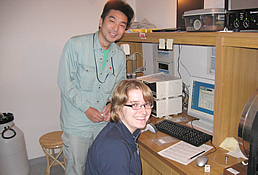
Night shift members of Palaeomagnetic Group. Kiichiro (left) and Beth (right). Beth is very friendly and Kiichiro does his work at his own pace.
Geomagnetism is a magnetic force that lets the compass indicate N or S to show which direction is north and south on the Earth. Today, the “N” on the compass indicates north, but in a very long term this has not stayed as the way it is now. In a large-scale planetary history, there are times when the “S” on the compass showed north, and it can repeat back and forth according to the palaeomagnetic conditions. And the times when these magnetic fields changed their directions have been studied by numerous scientists already. Now, do you have a brief idea what palaeomagnetists are trying to find out? The directions of geomagnetism are preserved within the sediments, thus by comparing the data collected in the past and the sediments being cored in this expedition let the palaeomagnetists establish the time when these layers were formed.
To put it simply, palaeomagnetists are measuring the geomagnetism in order to study different times of the Earth’s history when the layers were formed.
Next... I see someone working over there. Let’s ask him! He is from the “Structure Group”.
“I’m looking into the structures of the obtained boring cores.”
“Hmm... Could you tell me a little more specifically?”
“The cores have the layer’s deformation and fault information. These structure conditions are my research target.”
Then I asked him what has been interesting in this expedition so far, and he told me that the similarity in between deformed structures in the obtained cores and the terrestrial strata was quite significant and interesting.
The deformation within strata may appear in numerous versions. Some strata are physically cut due to some conditions, which are called “fault” or “dislocation”. Some get deformed when drained, while some change their directions of layers due to pressures. There are even signs of altered strata that may have been affected by biological effects!
The Structure Group also uses the CT scanner to identify deformations within the cores. CT scanner reminds us of the ones for medical use. Here on Chikyu, it is used to check what are contained in the sampled cores without physically damaging or destroying them. What is more special is that only Chikyu has CT scanner onboard among other drilling vessels. Isn’t it great!?
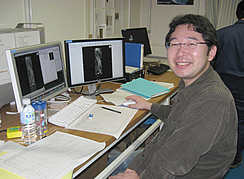
Asuka, a night-shifter of Structure Group. This group has only two scientists in charge so both night-shifter and day-shifter are busy! Asuka looks excited when he is looking at CT images.
Now, let’s talk to the members of the Physical Properties Group.
“Hi, how are you? What are you doing?”
They told me about different responsibilities each member holds. Hugh is measuring the physical strength of the strata, which is to check how much pressures the strata can hold.
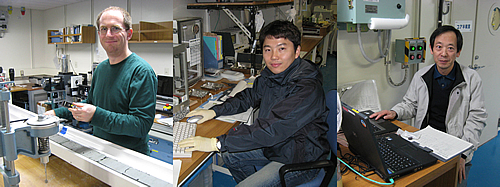
Night-shifters of Physical Properties Group. Hugh (left), Gwansoo (centre), and Osamu (right), doing different works. Hugh has a nice smile, Gwangsoo is stylish, and Osamu is calm...
Gwangsoo is mainly checking the weight of sediments and the water contained in them. By doing so, he can identify how tightly the particles are forming the sediments. This data is useful for finding out how the seismic waves travel below the seafloor and underground. He talked to me with his passion for his research! However, my understanding of his speciality was limited, so I need to stop here. I apologize for that.
I see Osamu observing the core’s temperature. Let’s ask him what he is trying to study. From what Osamu told me, the relationship between the depth of the strata and the temperature differ from place to place according to how the temperature travels, as the Earth’s centre is hotter and the outer layer cooler. By studying these differences, he can discover what is happening under the seafloor, and how heat affects the strata and the rocks. I see, Osamu is studying the heat, and he talked to me with his “heat” in his heart!
I can not introduce all the scientists at once (or I can not understand them all at once!) so I will continue with the interview and report it next time. Hopefully, see you soon!
Yasufumi Satoguchi


“The world 4,000 m beneath the surface of the sea and underneath”2010.12.27
Have you ever seen the world 4,000 m beneath the surface of the sea?
I suppose there are some people who have seen the deep sea expedition images on TV. I had never seen the actual seafloor, but I am right now looking at something that came from below the seafloor. This “something” is a part of sediments formed deep underneath the seafloor.
Chikyu is a deep sea drilling vessel, and the good thing about drilling expedition is that we can actually do “hands-on” researches on those normally unseen sub-seafloor environments and learn their composition structures. This kind of analysis can rarely be done so easily except on research vessels like Chikyu. The Expedition 333 is one of those exclusive research cruise and we are currently stopping the ship at offshore of Kii Peninsula and drilling deeper than 4,000 m and collecting sections of strata and rocks.
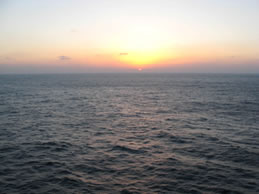
Sunset of the Earth. Surrounded by horizon, 360 degrees.
Imagine the depth of 4,000 m. Hard to imagine? Mt. Fuji is about 3,700 m, so if you think of this depth upside down, you can even reach higher than Mt. Fuji. It is THAT deep. We use a drill that is longer than the height of the Mt. Fuji. It is a great mission already to lower such a drill deep into the sea, but it does not only reach the seafloor, but it drills below the seafloor after arriving down there! Yes, it “drills” underneath the seafloor!!! (I had to repeat it, because it really does impress me.) Isn’t it great!? But maybe it is too hard to imagine…
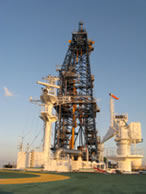
Derrick at sunset. This huge derrick is essential for dropping boring machinery to 4,000 m below the seafloor.
I would like to show you how the actual core looks like, but there is a regulation that says the actual core images must not be shown until the research results are officially released. So I can not show it to you at the moment, but when it comes out, I am sure you will enjoy looking at them. At least, I would be very happy if you could feel this excitement of us scientists onboard, holding up the sediments that came from 4,000 m below the seafloor. The recovered cores are to be taken by scientists onboard, and used for their different purposes of research. The cores are very valuable, so the research purposes are carefully examining. This means, you can not say you want some cores because you want to sow them in your garden to see how they would grow! What about my purpose of research? Well, like I explained last time, I was fortunately approved to get onboard and take samples for my research purpose. Each scientist requires necessary amount of core for their analyses. The amount of the core recovered from boring is limited, so the distribution is carefully considered and decided by the committee. The work going on during the cruise is basically collecting data including core description, and sampling and distributing the core retrieved in turn.
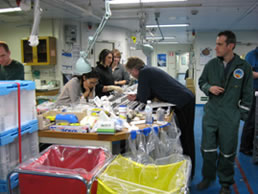
Sampling scene.
We work in turn. On the right is Dr. Pierre Henry, the Co-Chief Scientist.
He checks around to know everything that is going on during the entire cruise.
(Not just being too strict; it is his job to keep his eye on every single detail of the expedition work...)
It may be imagined that scientists are working very seriously. But in reality, we are working quite happily. This may be because we are in the state of cruise-exhaustion “high”... Since we are dealing with such valuable and precious cores, it is our duty to write proper research report and publish it as a paper. We have reports to give in during the cruise, and discussions and conclusions are being made onboard along with the on-going research works.
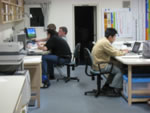
Writing research report. We work in groups for core description and analyses to produce a report. After we get off the ship, these papers are polished into scientific papers to be published.
Yasufumi Satoguchi


“It was my dream to be on Chikyu…”2010.12.20
Hi there, Konnichiwa. I am a scientist on board in Expedition 333, Dr. Satoguchi from Lake Biwa Museum. I am having busy days here. We are working in two shifts: the night shift starting from midnight and ending at midday, the afternoon shift from midday until midnight. I am working the night shift, so I feel like I am in a foreign country having jet lag, especially with English and French being spoken around me.
So, what did I say last time? Yes, I am going to introduce the scientists on board Chikyu. I think I should introduce myself first. As you know, Chikyu is operating drilling expeditions for Integrated Ocean Drilling Project (IODP), in which Japan is taking the leading part. IODP is an international project with a long history, which I knew about since I was a student. But, to me it was something that was happening in a remote world, so it was a kind of dream to do a research with such a great programme. In that context, I may say that I am making my dream come true right now.
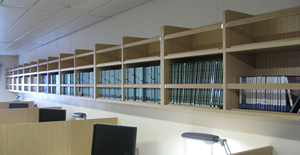
Chikyu’s onboard archive filled with a fading line of historical research reports!
Since I was a student, I have been doing researches on the volcanic ash found within the strata formed in between several million to hundreds of thousands of years ago from today. The volcanic ash is usually whitish in colour within the strata, and it is quite shiny compared to mud and sand, which is why I enjoy looking at them. The reason why it is shiny is because the volcanic ash is mostly made of the substance called ‘volcanic glass’. Volcanic glass is a glass naturally made by volcanic eruption. Imagine the gleaming powdery glass spreading by volcanic eruption and lying in between those sober strata…!
When I am doing a research, I look at volcanic ash using a microscope. I think you will be convinced when you look into the microscope and see how beautiful they are. Are you getting more interested in volcanic ash now? And I am sure when you get interested in something, you may want to check it out more by yourself.
Now, I explained that the volcanic ash is erupted when volcano erupts; you can see it is actually happening today in some places in Japan, for example in Kagoshima Prefecture. However, what I am studying are not of those volcanic eruptions that are happening frequently in smaller scale, but of much larger ones which can cover the area with several hundreds kilometres radius in one eruption, or even one that can cover the entire Japanese Archipelago with its ash. In this expedition, I am looking into such volcanic ash spread in extensive areas.
For example, some volcanic ash erupted in Oita Prefecture approximately 900,000 years to 1 million years ago can be found in offshore Kii Peninsula where we are drilling in the current expedition and even in Osaka Plain. I am expecting to find various volcanic ash this time because they are also found in Osaka and around Lake Biwa. Now, you may want to ask the reason why I want to find such volcanic ash. Let me explain.
It is very important to know for the scientists like myself, whose focus of study is geological strata; from what kind of substances the layers are made of, how they are being layered and how long ago they were formed, etc. Such information is the basic data for the deeper researches which are to be followed up by many other scientists. If we can find the volcanic ash of which we already know the date of eruption, then that would lead us to establish the date of in which the strata were formed. Occasionally, some marks of earthquakes may be found in geological layers in seismogenic zones. The volcanic ash is one of the key factors to help us learn when the earthquake occurred. Also, volcanic ash can deposit in the sea as well as on the land. This way, we can compare and analyse what happened at seafloor and on land at corresponding times of the history.
On the other hand, it is also my responsibility to describe the recovered sediments. We are a team of 6 scientists called “sedimentologist”, 3 members each for the afternoon and night shifts. Within the sedimentologist, we have different roles to play. Mine is to take a little of the sediments and see what they are made of by using a microscope. At the beginning, I was wondering how much work was waiting for me out there? Well, I didn’t think it was just sampling some volcanic ash... Now I tell you what I do. Of course, we cannot be like “Here’s the recovered core! It’s simply sand. Finished!” and go idling. We do work hard in day and night shifts, 12 hours each without even a weekend. I used to say, “I like sediments macroscopy and I have been doing the volcanic ash microscopy for quite a while. So there should not be a problem...” But the next thing I said after being told what other factors were for me to look into was this. “...What!? Do I also have to describe microorganisms and fossils contained AND find out their rations!?” Yet, I was still capable to say “Actually, if I take a bit more time, I can categorise them into similar groups. No problem!” Then I found out the numbers of cores to describe. Oh no, there were so MANY of them, serious! Will I ever finish!? This is a huge amount of work...! Well, the number of slides to describe was reconsidered after the first meeting. So, I am doing it okay at the moment. But still, it is a hard work to keep looking into the microscope everyday on a ship, although Chikyu does not roll that much. As a team, we take each share of taking the sample cores in turn (this is also a hard work!) and I go bother or joke a bit with Jan from Norway (sedimentologist) and Koray from USA who is doing an analysis called XRD. Each day passes busily like this...
One day, I was talking to Dr. Moe Kyaw (Expedition Project Manager) about how busy we have been everyday, he told me it is better we scientists have plenty of things to do, because when we have idling time doing nothing, that’s when there’s something wrong with the drilling work. I was totally convinced by his saying.
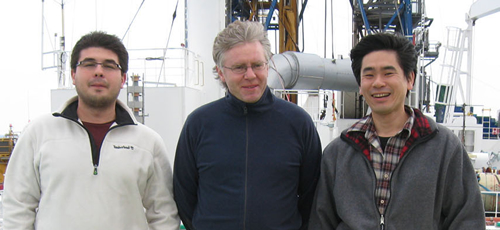
Sedimentologists for night shift. From left: Koray, Jan and myself.
Yasufumi Satoguchi


“Landing on Chikyu’s Helicopter Deck”2010.12.17
Hello, everyone out there. My name is Yasufumi Satoguchi, and I am a museum curator. I am delighted to have been told to write a series of report on what people are doing on Chikyu during this month-long expedition, thanks to Dr. Kanamatsu, the Co-Chief Scientist. Having been given this interesting job, I thought of reporting totally at my own discretion and prejudice, but I admit now secretly, that “twittering Chief Editor” will be checking every word I write here! Therefore, I will try to be sensible on my reports. (“Hey, you should not be too sensible and boring!” –by twittering Chief Editor) I think you probably know already what kind of research vessel Chikyu is, and what the people are doing on this ship. However, just in case you need to catch up; Chikyu is a drilling vessel that drills and researches the seafloor to unwrap the Earth’s mystery by international cooperation. Maybe some people want to ask what is so fun about making the Earth full of holes by drilling? I would rather say “Please look at this website!”
(I hear people complaining “You are a curator who should be able to explain about Science in an easy-to-understand form to everyone! Don’t just give us the website reference and go!”) Please forgive me for not explaining this time, but I will try to include some information in the following reports.
Many scientists including myself got aboard on the 11th December. However, for pre-cruise meetings, we gathered a few days beforehand in Yokohama. There was also a welcome party and the following picture is one taken in it. Is it only me who thought the picture on the door of this pub looked like Pierre (Dr. Pierre Henry), the Co-Chief Scientist of this cruise?
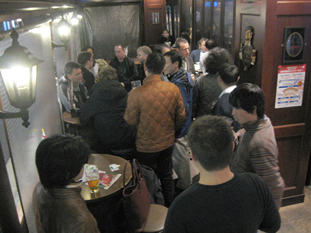
Since Chikyu was waiting for us in the middle of the sea this time, we got aboard by helicopter. As I found that small figure of Chikyu from distance caught from the helicopter window, she looked like a needle sticking out on the horizon, because she has got that famous, distinctive derrick. The helicopter approached Chikyu and I could see the real Chikyu similar to the small Chikyu model I saw somewhere. At first, I thought “Oh, Chikyu isn’t that big...?”, but when I landed on her helicopter deck, I could not believe I was really on a ship. In my head, a theme song of an animated Japanese Sci-Fi movie, which will be released as a new version this month, was playing repeatedly. We had various meetings until the core samples began to arrive on deck. Now, we are all busy working on gathering data, describing and analysing them. In my next report, I would like to introduce some of the scientists’ works.
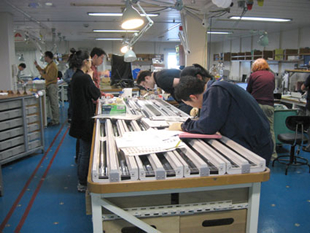
Working busily!
Yasufumi Satoguchi














